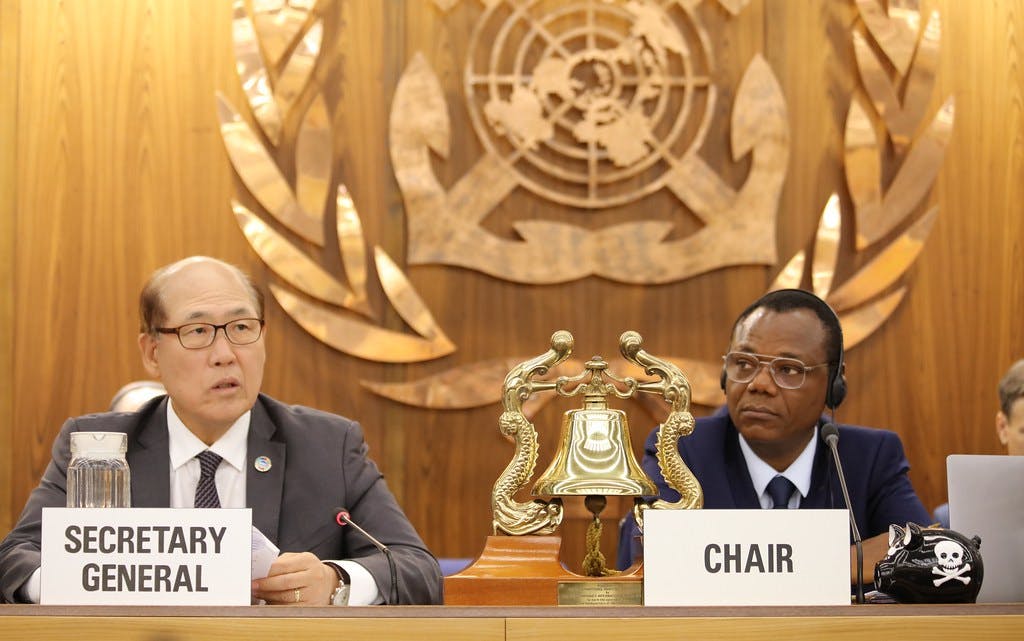After two weeks of tough negotiations, 175 member states of the International Maritime Organisation (IMO) failed to agree on absolute emission reduction targets by the middle of the century.
To continue reading, subscribe to Eco‑Business.
There's something for everyone. We offer a range of subscription plans.
- Access our stories and receive our Insights Weekly newsletter with the free EB Member plan.
- Unlock unlimited access to our content and archive with EB Circle.
- Publish your content with EB Premium.
Instead they settled on a revised target that looks at “striving for” curbing shipping emissions by up to 30 per cent by 2030, by up to 80 per cent by 2040, in order to reach net zero “by or around 2050”, depending on “national circumstances”, according to the final text of the resolution.
IMO secretary general Kitack Lim, however, described the adoption of the 2023 IMO greenhouse gas strategy as a “monumental development” for the organisation. He said it opens a new chapter towards maritime decarbonisation.
He also emphasised that the consensus is not the end goal. “It is in many ways a starting point for the work that needs to intensify even more over the years and decades ahead of us,” he told IMO delegates. “With the revised strategy that you have now agreed on, we have a clear direction, a common vision, and ambitious targets to guide us to deliver what the world expects from us.”
Experts criticised the target as lacking, as it does not do what is needed to keep the global rise in temperatures to below 1.5°C, in line with the Paris accord.
The new commitment is a “wish and a prayer agreement,” said John Maggs, president of Clean Shipping Coalition, a global international environmental organisation that focuses exclusively on shipping issues.
“The language [is] seemingly contrived to be vague and non-committal,” said Maggs.
“The most vulnerable put up an admirable fight for high ambition and significantly improved the agreement but we are still a long way from the IMO treating the climate crisis with the urgency that it deserves and that the public demands,” he added.

International Maritime Organisation secretary general Kitack Lim (left) during the opening of the 80th Session of the Marine Environment Protection Committee (MEPC) on 7 July 2023 at the IMO headquarters. Image: IMO
The Pacific Island countries, supported by the United States, the United Kingdom and Asian nations Japan and South Korea fought hard for an absolute zero emission target by 2050 but were opposed by China, backed by India, Indonesia, Brazil, and Argentina. China, India and Indonesia see shipping as a hard-to-abate sector, requiring more time to decarbonise.
While the inclusion of 2030 and 2040 emissions reduction targets for shipping is not insignificant, the agreement does not address the climate crisis, said Lucy Gilliam, senior shipping policy officer of non-profit Seas at Risk.
She noted how vulnerable groups were excluded from discussions until the final hour.
“The Pacific Island nations brought it back from the brink. But let’s be clear that the process was not transparent, just or equitable, and it is reflected in the result reached,” she said. “What’s especially egregious is that we have the know-how to tackle this crisis. We also know that action will be far cheaper than inaction.”
“
The most vulnerable put up an admirable fight for high ambition and significantly improved the agreement but we are still a long way from the IMO treating the climate crisis with the urgency that it deserves and that the public demands.
John Maggs, president, Clean Shipping Coalition
Global shipping is affected by sea level rise, severe storms, inland flooding, drought, extreme heat events, which if not addressed could cost the industry up to US$9.8 billion by 2050, based on research non-profit Environmental Defense Fund (EDF) published in 2022.
Within the wider industry, there is a recognition that reform is necessary but there is a concern that a higher level of ambition will be too challenging and expensive.
Research published this month by Netherlands-based consultancy CE Delft, however, shows that cutting shipping emissions by half this decade would only add some 10 per cent to the total costs of operations.
The IMO, which is the United Nations body that regulates the safety and environmental performance of international shipping, reconvened late last month for negotiations on the adoption of a net-zero shipping emissions reduction target by 2050, ramping up its previous climate plan that only aims to halve shipping emissions within the same time frame. The shipping talks had lasted for 14 days, before concluding on Friday (7 July).
Climate-vulnerable countries have been asking the IMO to adopt science-based targets by reducing emissions by at least 37 per cent by 2030 and by at least 96 per cent by 2040 and reach zero by 2050 at the latest.
Global shipping carries around 90 per cent of trade around the world, emitting around one billion tonnes of greenhouse gases every year. Halving shipping’s emissions footprint would be equivalent to shutting down 121 coal power plants.
What an ambitious shipping target means for Asia
Sources tell Eco-Business that China, the world’s largest shipowner based on 2022 United Nations data, opposed a higher shipping ambition because its own economy is not required to reach net zero by 2050.
Chinese president Xi Jinping announced three years ago that the superpower would achieve carbon neutrality by 2060.
The source, a founder of a Hong Kong-based institution that does consultation on automobile and vessel emissions, as well as climate change impacts, and who preferred to stay anonymous, said that the Chinese regards the IMO’s net-zero ambition as “unrealistic”.
“Many shipping companies and ports do not see a clear zero-emission fuel solution for seagoing shipping, hence it is accepted that the shipping sector be given more time to decarbonise, as compared to sectors that have a clear decarbonisation roadmap, such as power and on-road transport,” the source said.
India and Indonesia, ranked as the world’s leading ship-owners, likewise have set more relaxed carbon neutrality targets – net zero by 2070 and 2060 respectively – and they might have the same justification as China for not supporting net-zero shipping emissions by 2050, the source added.
Meanwhile, South Korea and Japan, which are among the world’s biggest ship builders, are in favour of net zero by 2050, because they need to maintain their competitiveness throughout the next decades and research into zero emission engines will help them achieve this, said John Yum, shipping lead at South Korea-based non-profit Solutions for Our Climate.
“South Korea and Japan have had the technology to build high-end ships. Higher climate ambitions will likely lead to more orders for zero-emissions ships, which are not yet on the market,” said Yum.
Japan has been working on its first ammonia-fuelled gas carrier due to be completed by 2026, while South Korea has been developing a blended fuel of liquefied natural gas and hydrogen which aims to use less toxic gas emissions.
Singapore has likewise been preparing for a multi-fuel future for the shipping industry, and the island state could be more prepared to meet a tighter timeline compared to other ports. Just this week, Singapore’s maritime port authority confirmed that the trade-reliant city-state expects ammonia bunkering to take place in its waters from 2026.
The Philippines, the world’s top provider of seafarers and maritime officers, declared its support for net-zero shipping emission reductions by 2050 at the start of the intersessional talks.
In preparation for the decarbonisation of the shipping industry, seafarers will need to be equipped with adequate skills and training to operate new technologies and handle alternative fuels like hydrogen and ammonia, which are being eyed for low-carbon shipping due to their potential in reducing greenhouse gas emissions to near-zero.
At a shipping conference held in Manila last month, president of Sweden-based World Maritime University Max Mejia said that this would include ramping up of Science, Technology, Engineering, and Math (STEM) learning as early as possible in the local educational system.
Countries with high level of STEM education, such as Japan, Singapore and Europe, do not have large seafarer populations, he said, while a seafarer-supplying country like the Philippines has not done so well in STEM.
Mejia believes the situation needs to change, and the Philippines must focus on promoting STEM education from a young age.











